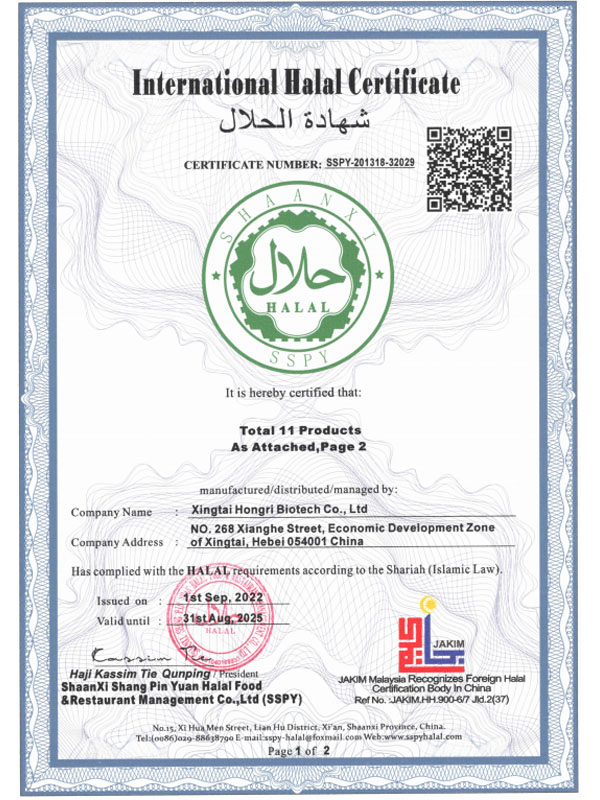- No. 268 Xianghe Street, Economic Development Zone of Xingtai city, Hebei 054001 China
- Byron@hbhongri.cn
Exploring the Flavors and Uses of Chili and Paprika Spices in Cooking
The World of Chili Paprika A Flavorful Journey
Chili paprika is a vibrant spice that brings a burst of color and flavor to a variety of dishes around the globe. Originating from the capsicum family of peppers, this spice is not only a staple in many kitchens but also a significant ingredient in numerous culinary traditions. Its unique flavor profile, which ranges from sweet to spicy depending on the type of chili used, makes it a versatile choice for chefs and home cooks alike.
The history of chili paprika is intertwined with the cultures of Central and South America, where indigenous peoples first cultivated peppers thousands of years ago. The spice later made its way to Europe with the explorations of Christopher Columbus in the late 15th century. It quickly gained popularity, particularly in Hungary and Spain, where it became a central component of many traditional dishes. In Hungary, for example, paprika is used to create the famous goulash, while in Spain, it plays a crucial role in the seasoning of paella.
Chili paprika comes in various forms, each with its own distinct flavor profile. The most common varieties include sweet, smoked, and hot paprika. Sweet paprika is generally milder and is often used for coloring dishes and adding a hint of sweetness. Smoked paprika, on the other hand, has a rich, smoky flavor, enhancing the depth of stews, marinades, and even roasted meats. Hot paprika can bring a fiery kick to meals, adding a layer of heat that can elevate a dish from ordinary to extraordinary.
One of the reasons chili paprika is cherished by cooks around the world is its health benefits. Rich in vitamins A and C, as well as antioxidants, this spice can contribute to a healthy diet. The capsaicin found in chili peppers is known for its anti-inflammatory properties and potential to boost metabolism, making paprika a smart choice for those looking to add flavor while maintaining health.
chili paprika

Culinary uses of chili paprika are endless. It can be sprinkled over roasted vegetables, stirred into soups and stews, or used as a rub for meats and fish. Beyond savory dishes, paprika can also add a unique touch to desserts, such as chocolate, where a hint of spice can create an unexpected but delightful flavor combination. Additionally, it is often used as a garnish, providing a vivid red contrast that can elevate the presentation of any plate.
In recent years, there has been a surge in popularity for chili paprika in the plant-based and vegan culinary scenes. Chefs are discovering how this spice can enhance the flavor of various vegetables, legumes, and grains, making them more appealing and delicious without the need for animal products. The use of chili paprika in vegan dishes showcases its adaptability and highlights the growing trend of incorporating bold flavors into healthier, plant-based meals.
Chili paprika also has an intriguing cultural aspect, often representing more than just a flavor. In places like Hungary, paprika is a point of national pride, celebrated in festivals and cooking competitions. It symbolizes the country’s agricultural heritage and cultural identity, binding communities through shared culinary traditions.
In conclusion, chili paprika is much more than a spice; it is a vibrant element of global cuisine that brings warmth, flavor, and health benefits to the table. Whether in a comforting bowl of goulash, a sophisticated dish of paella, or a simple roasted vegetable medley, the allure of chili paprika continues to inspire cooks and food lovers — proving that the right seasoning can transform a meal into a memorable culinary experience.
-
Unlock the Power of Capsicum Frutescens Fruit Extract – A Flavorful Boost for Your Products!NewsJul.22,2025
-
The Vibrant World of Powder Paprika – Unlock Flavor and Color in Your DishesNewsJul.22,2025
-
The Golden Power of Turmeric Root Powder – A Superfood for Every Kitchen!NewsJul.22,2025
-
Ignite Your Dishes with Crushed Red Chilli – A Spicy Delight Awaits!NewsJul.22,2025
-
Explore the Golden Benefits of Turmeric Powder – A Superfood for Every Kitchen!NewsJul.22,2025
-
Discover the Richness of Paprika Food – A Flavorful Journey Awaits!NewsJul.22,2025







